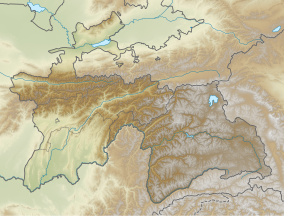Beshai Palangon (Бешаи Палангон) Reserve is in Tajikistan close to the Afghan border where the Vakhsh River and the Panj River join to form the Amu Darya. The reserve stretches over 40 km from the southwest to the northeast.
| Beshai Palangon (Бешаи Палангон) | |
|---|---|
| Location | Khatlon Province, |
| Coordinates | 37°16′N 68°28′E / 37.267°N 68.467°E |
| Area | 460 km2 (180 sq mi) |
| Established | 1953 |
| Criteria | Natural: ix |
| Reference | 1685 |
| Inscription | 2023 (45th Session) |
Description edit
The 460 km2 reserve is described by the WWF as the most important nature reserve in Central Asia, because of its large size and ecological diversity. In addition it is very important for rare species of tugay, or riparian forest, ecosystems.[1]
The highest elevations reach about 1,200 m above sea level.[2] The climate is continental and dry, the different habitats of Tigrovaya Balka comprise semideserts, savanna-like grasslands with pistachio trees and tugay vegetation with poplars, Russian silverberry and high grasses.
Fauna edit
The area was one of the last strongholds of the Caspian tiger, whose tracks were seen in the reserve for the last time in 1953.[3] As of today, Tigrovaya Balka is still home to the original main prey of the tiger, the rare Bactrian deer. Other larger species of the reserve include striped hyenas, golden jackals, swamp cats, wild boars, goitered gazelles, porcupines, the introduced nutrias,[3] gray wolves, red foxes and in hills also urials.
Birds edit
The reserve has been identified by BirdLife International as an Important Bird Area (IBA) because it supports significant numbers of the populations of various bird species, either as residents, or as overwintering, breeding or passage migrants. These include red-crested pochards, pygmy cormorants, saker falcons, common coots, common cranes, pale-backed pigeons, pallid scops-owls, Egyptian nightjars, white-winged woodpeckers, brown-necked ravens, great tits, desert larks, streaked scrub-warblers, Sykes's warblers, Asian desert warblers, saxaul sparrows and desert finches.[4]
External links edit
References edit
- ^ Description of Tigrovaya Balka Reserve at wwf.ru
- ^ S. Manzoor Alam,Atiya Habeeb Kidwai: Regional Imperatives In Utilization And Management Of Resources : India And the USSR. Naurang Rai Concept Publishing Company, New Delhi, India, 1987
- ^ a b Geptner, V.G., Sludskii, A. A., (1972) Mlekopitaiuščie Sovetskogo Soiuza. Vysšaia Škola, Moskva. (In Russian; English translation: Heptner, V.G.; Sludskii, A.A.; Bannikov, A.G.; (1992) Mammals of the Soviet Union. Volume II, Part 2: Carnivora (Hyaenas and Cats). Smithsonian Institution and the National Science Foundation, Washington DC). Pp. 95–202
- ^ a b "Tigrovaya Balka Nature Reserve". Important Bird Areas factsheet. BirdLife International. 2013. Retrieved 11 April 2013.
